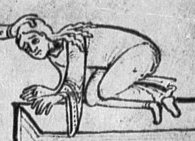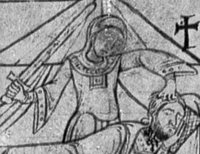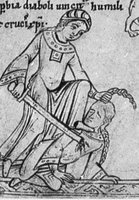The manuscript (Bayerische Staatsbibliothek, ms. lat. 14159)was made at Regensburg Abbey (not far from Salzburg, Austria) c1170/75. It measures 31cm by 21.5 cm and has 188 pages. Pictures of most (all?) of the illustrated pages can be found on Bildindex.
It's a lovely manuscript full of nice details, so I have to share it! Or at least some of the fantastic Austrian Women's fashions in it. I've only selected the pictures that are most interesting to me (mostly shorter skirts) there are more pictures (includign more women) on Bildindex.
Thanks to Wencenedl for help interpreting captions and identifying biblical stories fol.1r Ecclessia & crosstree
fol.1r Ecclessia & crosstree
- Well the modern german translation calls it a "crosstree", but it's a tree of life in the shape of a crucifix.
- Ecclessia is the personification of the church. This doesn't seem to be a typical pose.
- Ecclessia wears a calf length tunic with somewhat flared sleeves.
- The tunic is belted at the waist (you can see the overlap of the tunic, but not the belt)
- Trim is present at hem, cuffs and neck
- Her hair is braided, but I can't see other headwear under her crown, but it could be the poor angle.

 fol.2rTamar & signet ring & staff from Judah, Joseph & Potiphar's wife
fol.2rTamar & signet ring & staff from Judah, Joseph & Potiphar's wife- wikipedia on Tamar: Judah promised to her that his third son, Shelah, would become her husband. This promise was not fulfilled, and Tamar disguised herself as a temple prostitute and offered herself to her father-in-law Judah. She claimed his staff and signet as pledge of payment. When she later became pregnant and Judah accused her of fornication, she produced the staff and signet and identified Judah himself as the father."
- Potifar's wife is grabbing a piece of Joseph's (he of the dreamcoat) clothing to use as evidence to falsely accuse Joseph of rape.
- Tamar wears a plainish long dress with flared sleeves edged with trim. A veil covers her head.
- Potiphar's wife's tunic is calf length, belted at the waist with flared sleeves. Tunic is trimmed at cuffs and hem, and possibly a thin line at the neck too. Her hair is plaited, but there does appear to be something on her head too - a beanie hat?
- Wencenedl notes that Tamar is dressed as a prostitute (veiled!) and pontifar's wife should be dressed as a respectable wife. As both are on the same page, it's reasonable to expect the artist to have compared them.....And yet Tamar is more conservative, veiled (even as a prostitute).

 fol.3r Jael kills Sisera, Rahab hangs a red rope in the window
fol.3r Jael kills Sisera, Rahab hangs a red rope in the window- Jael killed a fleeing enemy army captain (by driving a tent peg through his head as he slept), thus preventing him returning with a new army.
- Rahab (a former prostitute) hid Jewish spies investigating the siege of Jericho. On the spies instructions she hung a red cord out the window,and thus her family was spared from massacre when the siege was broken.
- Jael (with the lovely chisel and mallet action) has one of her sleeves tucked back behind her elbow as she works
- Both ladies wear small beanie hats over veils (or possibly wimples) although Jael's is the classic shape, and Rahab's is split at the front like 2 leaves
- Rahab's dress has Byzantine influenced decoration on the front panel
- Again there appears to be no important difference in dress code between the (at some stage reformed) prostitute and the respectable householder.
 fol.3v Jephta sacrificers his daughter
fol.3v Jephta sacrificers his daughter- This appears to confirm the idea that unmarried women/girls would wear their hair loose while older ones would tie it up or cover it with a veil.
 fol.4r Elias and the widow of Zarephta
fol.4r Elias and the widow of Zarephta- Wikipedia (that wonderful source of dubious info) says " the prophet Elijah, .... multiplied the meal and oil of the widow of Zarephath (Sarepta) and raised her son from the dead"
- She is dressed in a calf length tunic, belted at the waist. Trim is present at hem and cuffs.
- She wears a veil over the dress.
 fol.4v Judith kills Holofernes
fol.4v Judith kills Holofernes- Judith is a jewish folk hero, seducing an enemy army captain (Holofernes) so she could kil him in his sleep. (look at teh parallels with Jael)
- Judith wears a tunic with flared sleeves, belted waist and decoration at collar and cuff.
- Her lower body is not visible.
- The cuff of the garment under her tunic (chemise or underdress) is decorated with trim.
- She wears a veil, but it does not cover the decoration at the collar (so does Rahab above). I've supposed several other examples of dreses without decoration at collar were such because a veil rendered the decoration imposible to see/draw, but this disproves this as a constant fact. (it may still be true sometimes).
- There is annother man on this page (not pictured - follow link) wearing a beanie hat, this one flat across the bottom.
 fol.5r Superbia vanquished by Humilitas
fol.5r Superbia vanquished by Humilitas- Superbia or Pride is one of the personified vices, and Humilitas/Humility her opposite virtue.
- Look at the lovely depictions of braided hair. Looks just like a 3 strand plait.
- Humility wears a long tunic with flared cuffs. It is decorated at cuff and collar. It is probably belted at the waist. She wears a beanie hat over her plaits (doesn't seem to be a veil) , that again vees above the forehead.
- What is visible of Superbia's clothing is almost identical, except no hat.
- Medieval bestiaries (eg Aberdeen bestiary) draw links between a peacock's brilliant plumage and vanity, showing a consciousness of pride of appearance, and yet Superbia is not dressed any more vainly than Humilitas. While Pride takes in a much greater scope than simple narcissism, it does include it. So I find it surprising that this simple to show symptom of one type of pride isn't used to help build the stereotype of Pride. They just don't seem to have chosen this option. So I can't consequently draw any links between Humility's clothes and what was modest clothing of the day. Damn.
fol.5v The mystical Paradise (Not pictured - follow link)
- Supporters include several virtues wearing clothing in the same style as the above examples. I haven't included them as we can only see their upper bodies.
- The central figure (Jesus?) has a nice example of a beanie hat that vees at the forehead.
fol.6r Cross filled with people (Not pictured - follow link)
- Several female supporters (possibly virtues?) in the same mould as the figures above.
- Hair worn loose, only upper body visible.
Other pages from this manuscript on bildindex:
fol.1v, fol.2v, fol.8v, fol.9r, fol.46v, fol.187v, fol.188v.
Conclusions:
- This style does seem to be consistant with the other manuscripts of the area and time. (i'll try to explain why I think this in a later post hopefully.
- There doesn't seem to be any clothing conventions to mark women as prositutes in this time and place.
- New dress features: beanie hats that aren't flat along their bottom edge.

No comments:
Post a Comment